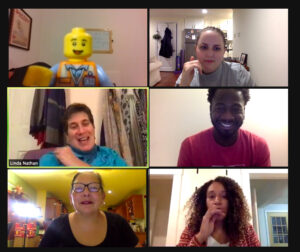Last week, New York City’s re-shuttering of schools reinforced what we have known since late spring: our political leaders prioritized the opening of bars and gyms over schools, leaving teachers and working families to take the hit. While we hear of a few school systems that have returned to hybrid education in ways that are giving educators choice and agency over their professional lives and their health, in most large urban school districts the plan has been, to put it bluntly, a mess.
Every educator I have spoken with misses being with their students in real time, and tells me about the feelings of isolation they experience teaching online—the energy of a classroom is irreplaceable. But a few of our emerging leaders tell me that the pandemic has given them the unexpected opportunity to take new creative risks that would not have been possible in the rush and tumble of “regular” school. In a counterintuitive way, the restraints of the current moment have created conditions in which creativity can thrive.
Katie, a 10th grade ELA inclusion teacher at the Mary Lyon Pilot High School in Boston, has introduced Henrietta Lacks in her curriculum. In the 1950s, Lacks, a Black woman, was diagnosed with cervical cancer, and her cells (taken without her consent)—termed HeLa cells—have been instrumental in furthering medical research. Her students are discussing the systemic racism pervasive in science that veils the real story of Lacks and her family. To complement this unit, Katie is trying to schedule a scientist who actually has worked with HeLa cells to make a virtual visit to her classroom so that her students can continue this dialogue with a professional (and a fresh face!) working in the field. “I’ve never seen my students so excited to meet a scientist before. They have so many questions.” Even though Katie has struggled with some students who have yet to turn on their video this year, she is emboldened by the opportunity to meet one-on-one with other students through office hours, which in the fast and crammed pace of in person school is often non existent.
Kareem, a Math teacher at Putnam Avenue Upper School in Cambridge, tells me that he doesn’t think he’ll ever teach math without digital tools again. “For me, paper is out… I love how much control my students have over their own learning while working on their Chromebooks which everyone has. Equations are coming alive for them in ways that I hadn’t seen possible before because of the digital programs I can now give them access to. I tried my first long term project in math and it actually went well.”
I am proud that Katie and Kareem are alums of the Perrone-Sizer Institute for Creative Leadership (PSi). They are working alongside other teachers whom they are coaching to think in new ways about teaching and learning. While certainly digital learning cannot be mistaken for nirvana, Katie and Kareem are using muscles they developed in PSi to be creative leaders who assess and leverage community resources for the benefit of their students; who strategically and gracefully improvise; who use an iterative process to hone in on quality over quantity; and who critique in the artist’s sense of the word, giving critical feedback, free of worries about how it will be judged.
Now more than ever, we need leaders who think differently.. Some say this forced rush to technology will improve education. I have certainly always advocated for “doing school differently,” and there are many useful things to learn in the face of this challenge, as Katie and Kareem can attest. Still, evidence of the disadvantages are mounting.
Principals have become crisis center managers: they meet with faculty who feel overwhelmed and ineffective despite years of classroom experience, and then they hop into their cars to deliver meals to students and families—all while fielding a daily barrage of new mandates as districts try to figure out how to move forward. Middle and high school teachers tell me about the profound sense of disconnect stemming from “teaching into little black boxes” created by students who choose to keep their cameras off. Elementary school teachers talk about trying to engage young students who are participating from their bedrooms, vying for quiet space and screen time with siblings, caregivers, and cats who love warm keyboards. “Zoom fatigue” is setting in for everyone.
We are all doing our best, but education is difficult and lonely work for adults and students alike right now. The fissures caused by inequity that were already present in American public education are becoming schisms in this pandemic. The ruthless focus on high stakes testing that remains, even in this context, lacks the creativity and compassion that our communities need to move forward together.
Still, I have hope, and I am, as I have always been, energized by the work our teachers and leaders are doing. Each year, I’m honored that PSi affords me the opportunity to work with emerging leaders from schools throughout the region. Teaching and learning happen best when we are in a supportive community with one another. I’m still connected to so many of the educators and leaders I have worked with over the years, and through my writing, I want you to be connected to them as well—because no leader will make it through this crisis alone. Katie and Kareem sharing stories with PSi Cohort 4
Katie and Kareem sharing stories with PSi Cohort 4
